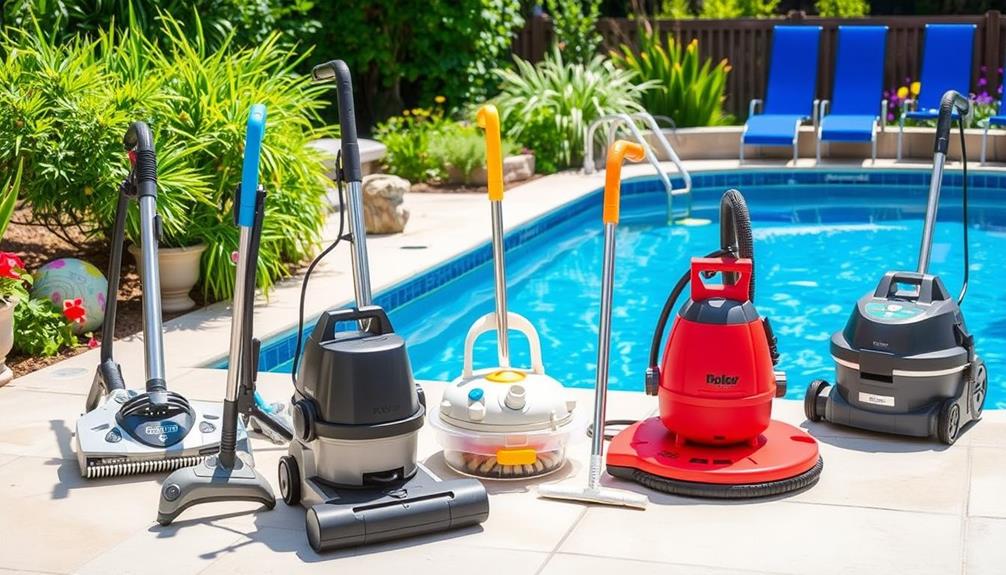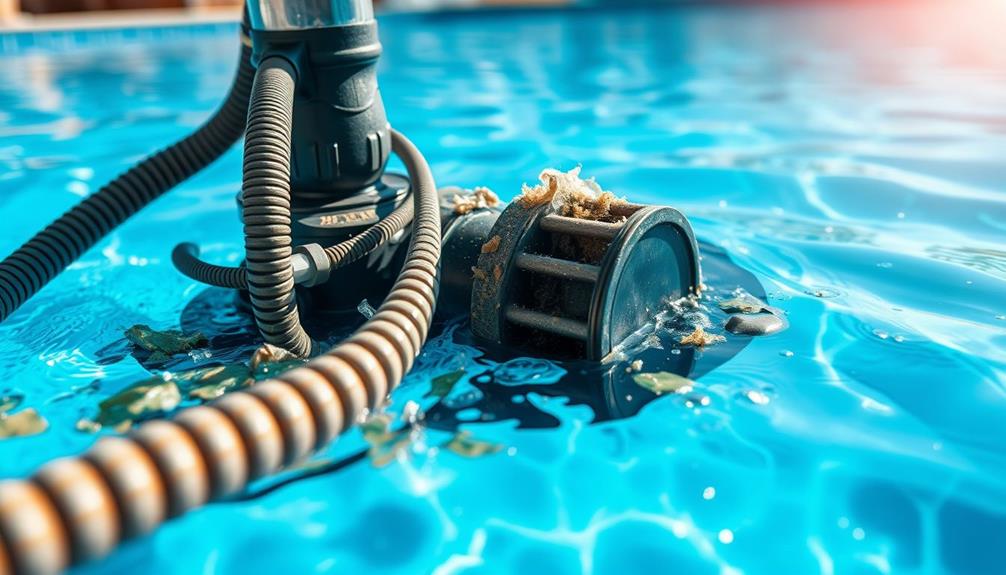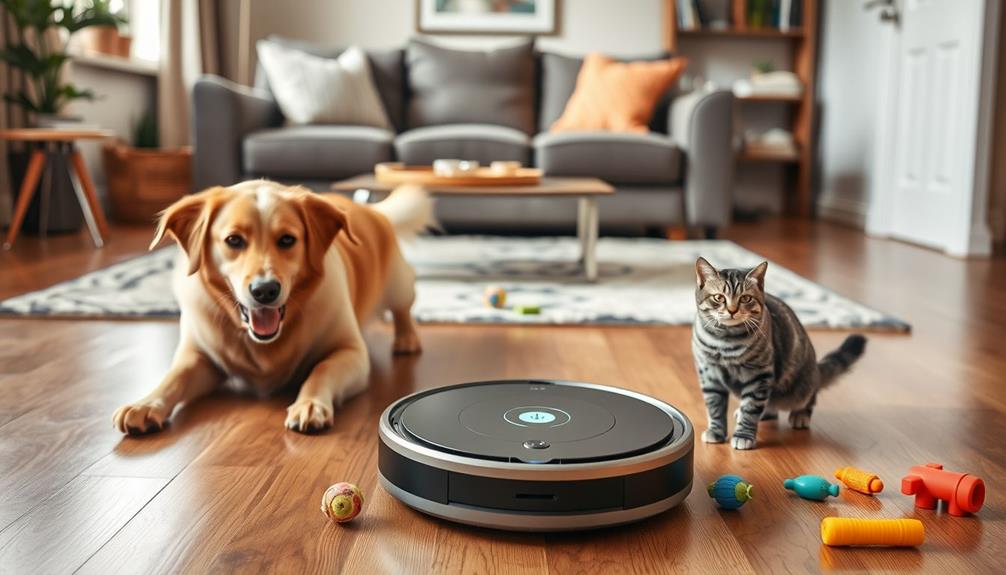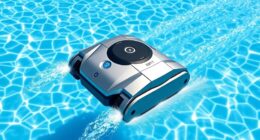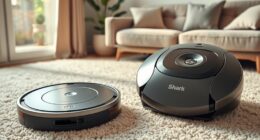Choosing the correct above ground pool vacuum is crucial in making pool maintenance easier and ensuring your water remains clear. When deciding on a vacuum, take into account the different types available: suction-side vacuums are cost-effective for smaller pools, while pressure-side vacuums are better suited for larger debris but may require a booster pump. Robotic cleaners provide advanced navigation and autonomy, making them ideal for those with busy schedules, and cordless vacuums are great for quick cleanups. Consider your pool size and the type of debris typically found in your pool to determine the best match. With a variety of options available, you are sure to find a vacuum that fits your needs and budget. Keep exploring to discover more tips and options for finding the perfect pool vacuum!
Key Takeaways
- Identify the type of vacuum that suits your needs: suction-side, pressure-side, robotic, cordless, or hybrid models based on pool size and debris type.
- Consider the cleaning technology and ease of use features, such as programmable timers and cordless options, for a hassle-free experience.
- Evaluate your budget, including initial costs and ongoing maintenance expenses, to make an informed decision on the right vacuum.
- Analyze the performance of top models, like Dolphin Escape and Aiper Scuba S1, to find one that meets your specific cleaning requirements.
- Regular maintenance practices, such as cleaning filters and inspecting hoses, ensure optimal performance and longevity of your chosen vacuum.
Types of Above Ground Pool Vacuums
When it comes to choosing the right above ground pool vacuum, you'll find several types tailored to different cleaning needs.
Suction-side vacuums are a cost-effective choice for smaller above ground pools. They connect to your pool's filtration system and use suction power to remove debris efficiently, making them a practical option for routine maintenance.
If you're dealing with larger debris, pressure-side vacuums might be the way to go. These models utilize water pressure from the pool's return jets but often need a booster pump for peak performance, ensuring that even the toughest messes are handled effectively.
For those seeking convenience with advanced features, robotic cleaners are highly efficient. Equipped with their own motor and filtration, these vacuums can tackle various debris types and clean all surfaces thanks to their advanced navigation technology.
Additionally, many robotic vacuums also come with smart technology, allowing you to control them via a mobile app for a more tailored cleaning experience, similar to what to look for in a home cleaning service.
If you prefer portability, cordless vacuums offer a hassle-free option, allowing for quick cleanups, though they may have shorter runtimes.
Lastly, hybrid models combine features from both suction and robotic cleaners. They strike a balance between affordability and advanced cleaning capabilities, making them suitable for diverse pool maintenance needs.
Understanding these types will help you choose the best vacuum for your above ground pool.
Factors to Consider Before Buying
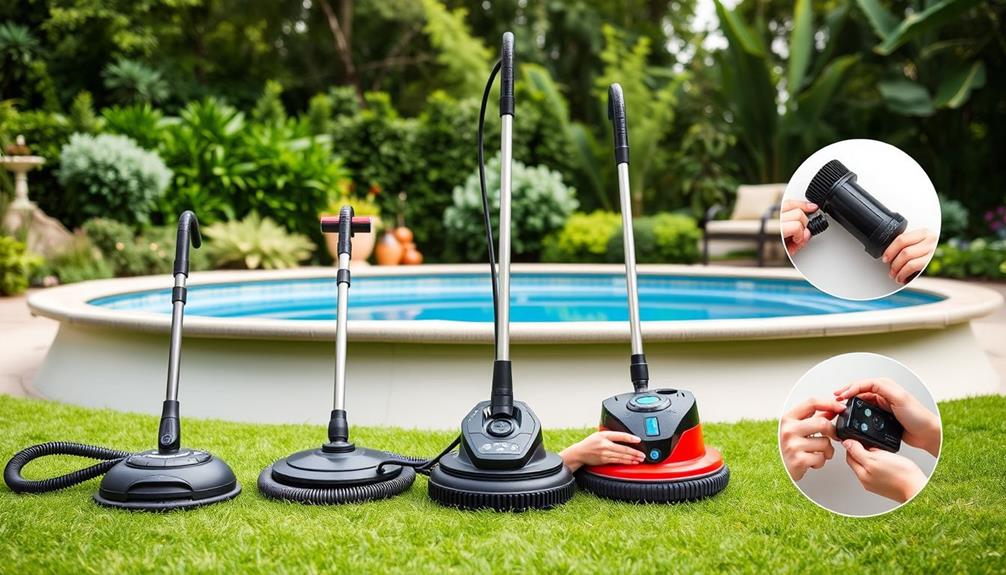
Before you invest in an above ground pool vacuum, it's crucial to carefully consider several key factors to guarantee you choose the right one for your needs. One consideration is the size and shape of your pool, as this will determine the type of vacuum that will work best. You’ll also want to take into account your budget and whether you prefer a manual or automatic vacuum. In some cases, manual pool skimmers may be a more cost-effective option for smaller pools or those with minimal debris.
First, assess your pool size; some vacuums are better suited for smaller pools, while others can efficiently tackle larger dimensions. Next, think about the debris type you usually encounter—whether it's leaves, sand, or fine particles—so you can select a vacuum that excels with those materials.
For example, if you often deal with pet hair, you might want to explore vacuums with features like anti-tangle technology that help manage stubborn debris.
Cleaning technology is another critical factor. Familiarize yourself with the differences between suction-side, pressure-side, and robotic vacuums, as each has its own advantages for various cleaning requirements.
Additionally, ease of use matters; look for features like programmable timers and cordless operation to simplify your cleaning routine.
Lastly, establish a budget that includes not just the initial price but also ongoing maintenance costs, replacement parts, and energy consumption.
Performance Comparison of Top Models
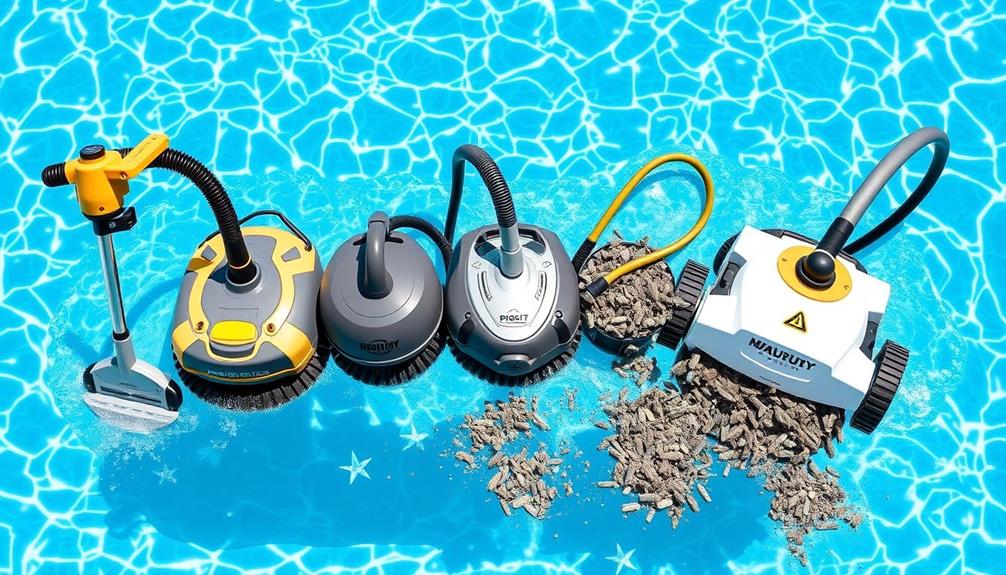
In today's market, choosing the right above ground pool vacuum can be overwhelming given the variety of models available.
Let's break down the performance comparison of top models to help you decide. When considering your options, it's crucial to look at features such as top robotic vacuums that enhance pool maintenance and automate cleaning tasks.
The Dolphin Escape excels with its SmartNav 2.0 technology, ensuring efficient navigation and minimal manual intervention while maintaining great cleaning efficiency. It also features a top-loading basket for easy debris removal.
If your pool is up to 33 feet, the Dolphin E10 is a solid choice, equipped with powerful scrubbing brushes and a similar top-loading basket for straightforward debris disposal.
For those who prefer cordless operation, the Aiper Scuba S1 stands out with smart route planning and a powerful battery, making it effective for various debris types in above ground pools.
The Water Tech Pool Blaster Max Li also offers cordless convenience with its 10.5-inch vacuum head, perfect for maneuvering around stairs and tight spots.
However, the WYBOT Cordless Robotic Cleaner, while lightweight and suitable for pools up to 525 square feet, may struggle with heavier debris, highlighting the importance of aligning your choice with your specific cleaning needs.
Maintenance and Care Tips
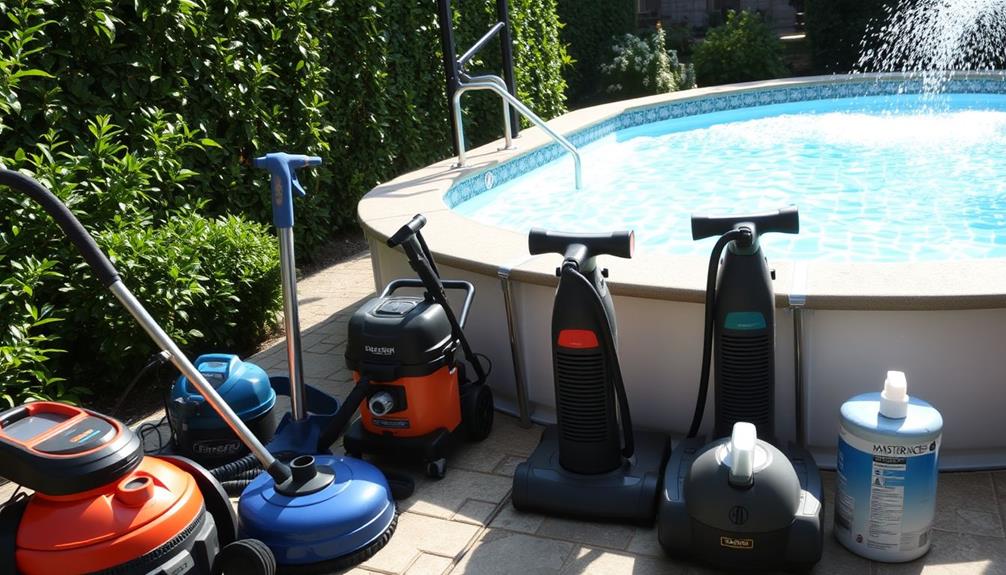
To keep your above-ground pool vacuum running smoothly and efficiently, regular maintenance is essential. Start by cleaning the filters and brushes often; clogged filters can greatly hinder suction power and overall efficiency.
It's also important to remove large debris from the pool before using the vacuum. This simple step helps prevent clogs and guarantees smoother operation during cleaning cycles. Additionally, maintaining a clean environment around the vacuum can enhance its performance, similar to how air purifiers improve indoor air quality by reducing allergens and harmful particles.
Store your vacuum in a cool, dry place when not in use to protect it from harsh weather conditions, which can extend its lifespan. Regularly inspect the vacuum's hoses and cables for signs of wear and tear—replace any damaged parts promptly to avoid operational issues down the line.
Follow the manufacturer's guidelines for seasonal maintenance checks. This may include checking the battery (if cordless), cleaning the waterline, and verifying all components are functioning properly.
Cost Analysis and Budget Options
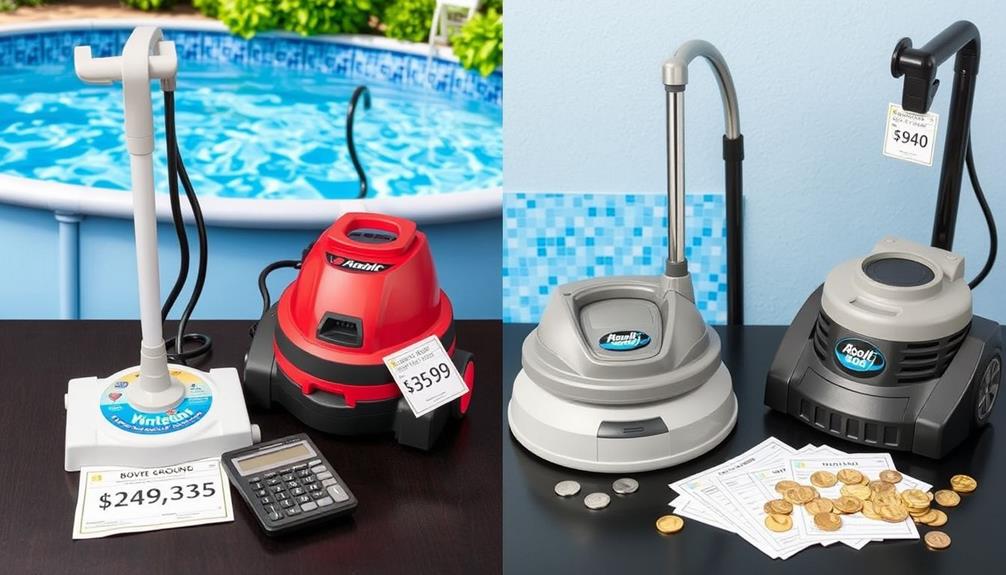
When you're looking for an above-ground pool vacuum, it's crucial to understand the pricing tiers.
Entry-level models are budget-friendly, ranging from $100 to $300, while mid-range options offer better features between $300 and $700.
For instance, pool maintenance solutions can greatly enhance your cleaning experience and efficiency.
Knowing these price points can help you choose a vacuum that fits your needs and budget.
Entry-Level Model Pricing
Exploring entry-level above ground pool vacuums reveals a range of options priced between $100 and $300, making them ideal for those on a budget.
These affordable options, like the Poolwhale Pool & Spa Vacuum and Zodiac Baracuda G3, offer effective debris removal without breaking the bank. However, many models require manual operation or connection to your pool's filtration system, increasing the time and effort needed for cleaning.
Similar to the Bissell Pet Hair Eraser Vacuum, which is designed for efficient hair removal, these entry-level vacuums provide a straightforward cleaning solution.
While these entry-level vacuums are cost-effective, they often lack advanced features found in higher-end robotic cleaners. You won't find programmable schedules or smart navigation in these models, which can make pool maintenance a bit more hands-on.
It's also essential to evaluate long-term costs. Regular maintenance and occasional replacement of parts can add up, impacting your overall budget.
When choosing an entry-level vacuum, weigh the initial cost against potential future expenses. If you're looking for a simple and efficient solution for your pool cleaning needs, entry-level vacuums can be a solid choice, as long as you're prepared for the manual work and upkeep involved.
Mid-Range Features Comparison
Mid-range above ground pool vacuums, typically priced between $300 and $700, strike a balance between affordability and enhanced cleaning capabilities. Models like the Dolphin Escape and Dolphin E10, both around $499, come equipped with effective scrubbing brushes and easy debris removal systems. The Polaris Vac-Sweep 280, priced at $599, is recognized for its effective cleaning cycle and user-friendly design, making it a solid choice for mid-range budgets.
Here's a quick comparison of some popular mid-range options:
| Model | Price | Key Features |
|---|---|---|
| Dolphin Escape | $499 | Effective scrubbing brushes, timers |
| Dolphin E10 | $499 | Easy debris removal, programmable |
| Polaris Vac-Sweep 280 | $599 | Advanced navigation, efficient cycle |
Investing in mid-range above ground pool vacuums can save on long-term maintenance costs by reducing manual cleaning efforts and prolonging pool equipment lifespan. Features like programmable timers and advanced navigation technology enhance overall cleaning efficiency compared to entry-level models, making them a savvy investment for your pool care.
User Experiences and Testimonials
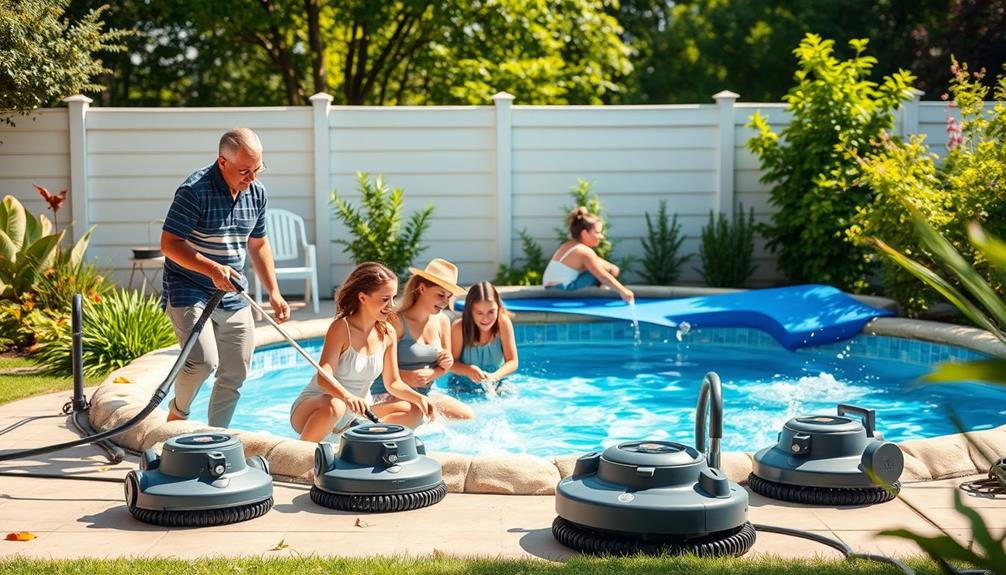
User experiences with above ground pool vacuums reveal a range of satisfaction levels based on their specific needs and preferences. Many users appreciate the diverse features these vacuums offer, contributing to their overall performance and efficiency.
For instance, incorporating games like charades or Pictionary during pool parties can enhance the experience, making cleaning feel more like fun and less like a chore Crazy Games for Friend Hangouts.
- The Dolphin Escape impresses with its efficient cleaning and SmartNav 2.0 technology, making navigation effortless.
- For those needing quick cleanups, the WYBOT Cordless Robotic Pool Cleaner stands out for its lightweight design and easy-to-use functionality.
- The Pool Blaster Max Li shines in maneuverability, especially on stairs and tight spots, thanks to its cordless operation.
- Users find the Hayward Navigator Pro simple regarding setup and operation, though some mention it requires more frequent emptying due to its strong suction capabilities.
Testimonials also highlight the performance of the Zodiac Baracuda G3, particularly in tackling gritty debris, but users advise that the initial setup can be time-consuming.
Frequently Asked Questions
What Is the Number One Pool Vacuum?
The number one pool vacuum you should consider is the Dolphin Escape.
It's praised for its efficient cleaning and SmartNav 2.0 technology, ensuring your pool gets thorough coverage. Priced at $499, it's a cost-effective choice for pools up to 33 feet.
With a top-loading basket for easy debris removal, it operates independently, making maintenance a breeze.
Plus, it's backed by a full 2-year warranty, giving you peace of mind with your purchase.
Which Is Better Manual or Automatic Pool Vacuum?
You might think manual pool vacuums are just as good as automatic ones, but that's not the case.
While manual vacuums require your effort and time, automatic models do the work for you. They navigate your pool efficiently, saving you both energy and hassle.
Plus, they protect your filtration system from strain. If you value convenience and consistent cleaning, you'll likely find an automatic vacuum's benefits far outweigh those of a manual option.
What Is the Best Way to Vacuum an Above-Ground Pool?
The best way to vacuum your above-ground pool is to use a specialized vacuum designed for it, like the Dolphin Escape or Water Tech Pool Blaster Max Li.
These options efficiently remove debris.
If you prefer manual vacuuming, a lightweight vacuum on a telescopic pole works well but requires more effort.
Regularly vacuum 2-3 times a week during peak season to maintain hygiene and prevent algae growth, ensuring a clean swimming environment.
How Long Do Pool Vacuums Last?
Did you know that the average lifespan of above ground pool vacuums ranges from 3 to 8 years?
How long your vacuum lasts depends on the model and how well you maintain it.
Robotic vacuums tend to outlast others due to their sturdy design.
Regularly cleaning filters and storing your vacuum properly during the off-season can help extend its life.
Warranties can also give you an idea of expected durability.
Conclusion
In the end, choosing the right above ground pool vacuum boils down to your specific needs and preferences. Whether you want a manual cleaner for a hands-on approach or a robotic one for effortless maintenance, there's a perfect fit for you. Don't forget to weigh performance, pricing, and user experiences to find the best bang for your buck. Remember, when it comes to pool care, you've got to strike while the iron's hot to keep your pool sparkling clean!
